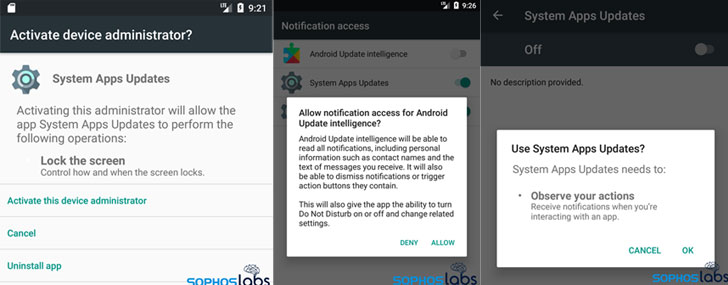A threat actor known for striking targets in the Middle East has
evolved its Android spyware yet again with enhanced capabilities
that allow it to be stealthier and more persistent while passing
off as seemingly innocuous app updates to stay under the radar.
The new variants have “incorporated new features into their
malicious apps that make them more resilient to actions by users,
who might try to remove them manually, and to security and web
hosting companies that attempt to block access to, or shut down,
their command-and-control server domains,” Sophos threat researcher
Pankaj Kohli said[1]
in a report published Tuesday.
Also known by the monikers VAMP[2], FrozenCell[3], GnatSpy[4], and Desert Scorpion[5], the mobile spyware has
been a preferred tool of choice for the APT-C-23 threat group since
at least 2017, with successive iterations[6]
featuring extended surveillance functionality to vacuum files,
images, contacts and call logs, read notifications from messaging
apps, record calls (including WhatsApp), and dismiss notifications
from built-in Android security apps.
In the past, the malware has been distributed via fake Android
app stores under the guise of AndroidUpdate, Threema, and Telegram.
The latest campaign is no different in that they take the form of
apps that purport to install updates on the target’s phone with
names such as App Updates, System Apps Updates, and Android Update
Intelligence. It’s believed that the attackers deliver the spyware
app by sending a download link to the targets through smishing messages[7].
Once installed, the app begins requesting for invasive
permissions to perform a string of malicious activities that are
designed to slip past any attempts to manually remove the malware.
The app not only changes its icon to hide behind popular apps such
as Chrome, Google, Google Play, and YouTube, in the event the user
were to click the fraudulent icon, the legitimate version of the
app is launched, while running surveillance tasks in the
background.
“Spyware is a growing threat in an increasingly connected
world,” Kohli said. “The Android spyware linked to APT-C-23 has
been around for at least four years, and attackers continue to
develop it with new techniques that evade detection and
removal.”
References
- ^
said
(news.sophos.com) - ^
VAMP
(unit42.paloaltonetworks.com) - ^
FrozenCell
(blog.lookout.com) - ^
GnatSpy
(blog.trendmicro.com) - ^
Desert
Scorpion (blog.lookout.com) - ^
successive iterations
(thehackernews.com) - ^
smishing
messages (www.proofpoint.com)
Read more https://thehackernews.com/2021/11/apt-c-23-hackers-using-new-android.html

